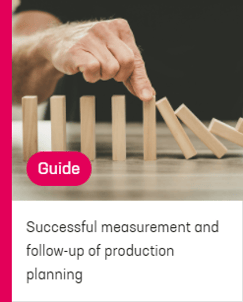 Production planning is often an invisible job in manufacturing companies, the success and efficiency of which is difficult to monitor and evaluate. The planning is often quite invisible – until an error occurs.
Production planning is often an invisible job in manufacturing companies, the success and efficiency of which is difficult to monitor and evaluate. The planning is often quite invisible – until an error occurs.
Examining production planning requires an in-depth reflection on what elements the planning actually consists of, what is required to succeed, and which elements are critical to success. When conducting an analysis, it is important to know what things the company wants to focus on in its production, and to look at the success of production planning in the light of these goals.
Is the fastest possible customer deliveries, quality and customization, the optimal level of service for key customers the company’s focus and competitive advantage, or something else? As with production, the goal of production planning is basically based on the strategy the company has chosen for its business.
Use of time, data availability, predictability
When the strategy-based goals for production and thus also for production planning are laid out, it is easier to analyze performance in terms of different variables. A well-established way is to evaluate it through three perspectives: use of time, data availability, and predictability.
In order for production planning to work effectively and contribute to the desired goals, one must be able to plan the production within a reasonable time and not only provide the necessary information for production personnel but also for sales and management, among others. In addition, planning plays an important role in ensuring that production can be organized as efficiently as possible and that its various stages are organized in an optimal way. In other words, at its best, production planning allows for good predictability of the entire production-related business.
Developing production planning often requires making the things hidden in the background visible. This is related to business objectives and their implementation, the information needed for planning, as well as the various stages of planning work and principles that guide them. Simplifying these issues is worthwhile, as good planning not only improves success in its own metrics but also in key metrics for the entire business.
When the invisible becomes visible, clear, strategy-based goals can be assigned to production planning, and it can be broken down into appropriately sized parts that enable the use of metrics and monitoring, and this information can be used to draw a path from current performance to goal status.
Went to know more?
We have also published a complete Guide to Successfully Measuring and Monitoring Production Planning, in which we go into more detail on factors related to, among other things, time planning, data availability and predictability in production planning.
Read more:
Blog: Towards an environment of systems – how does an APS system complement an ERP system?
Success Story: Clear time and cost savings at Snellman with iPES
iPES by Pinja - Production planning and supply chain management system
Back to the Pinja Blog
Categories
- Career at Pinja (68)
- Manufacturing (48)
- Knowledge Management (45)
- Production Development (44)
- Software Partnership & Tools (42)
- Sustainability (37)
- Wood and Forestry (37)
- Bioenergy and Recycling (27)
- IT Support and Outsourcing (24)
- Ecommerce (23)
- Maintenance (22)
- Artificial Intelligence and Machine Learning (15)
- Public Services (9)
- Compliance (1)

